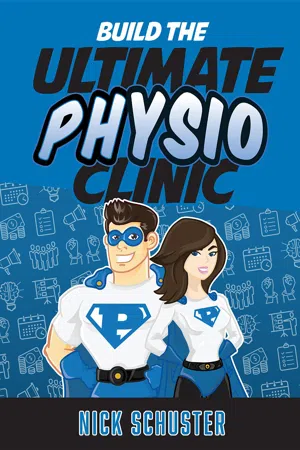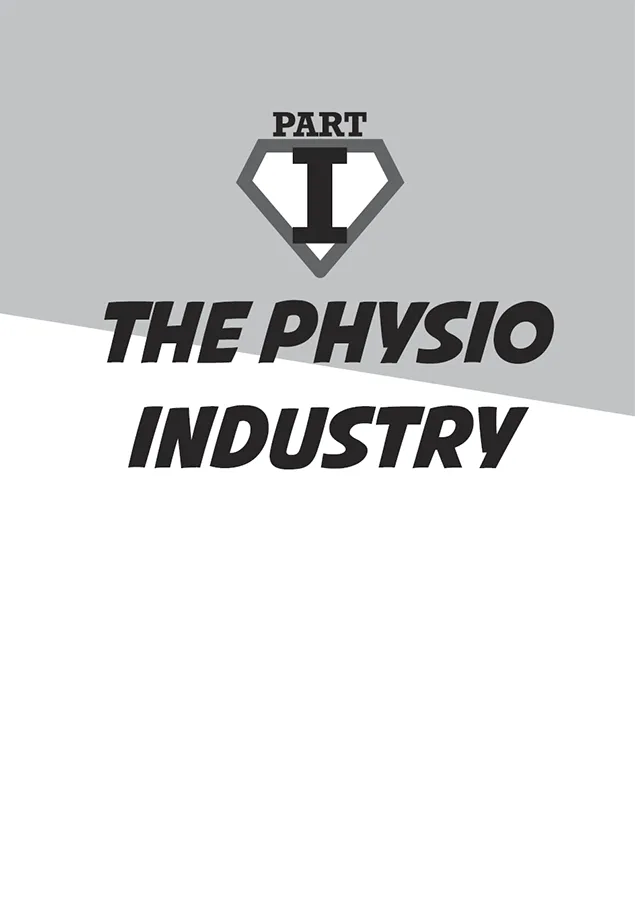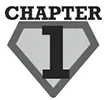![]()
![]()
WHAT IS AN ULTIMATE PHYSIO CLINIC?
IMAGINE ...
Close your eyes for a minute. Imagine this …
You wake up on a Monday morning, but not too early – and you don’t need an alarm. You have time to have a nice, relaxed breakfast with your family before heading in to work. On the weekend before you didn’t even think about work, let alone take any work home.
As you drive to work your mind is clear. You have a list with everything you need to do on it, so you aren’t constantly thinking about all the things you have to do or all the hats you need to wear in your business. On the way to work you listen to music, listen to a podcast, or – as I prefer – drive in complete silence so you can let thoughts come to you about what you need to be working on to continue to improve your clinic.
You own a large clinic, and own the building it is situated in. It is about 8:30 am, and you get out of your car, which you park in the car space reserved for you, which is closest to the building. When you enter the clinic the place is humming. And you didn’t even have to be the first in the door. Your clinic has 9 or 10 consulting rooms, and two large, open gym and exercise areas. Your clinic waiting room is professionally designed, and almost every seat is taken, which is normal each morning when you arrive.
You are greeted by two smiling receptionists – one senior and one junior. Your reception area is staffed with two team members during busy times, and down to one during quiet times, to make sure your admin wages bill isn’t too high. New patients check in using your cutting-edge software, to save your admin team time.
When you sit down at your desk in your office with a view (with no treatment bed in it), you start your weekly planning and numbers analysis of the previous week. You open your diary and correlate it with your practice management software. Each day you have meetings with different members of your leadership team – three senior physios and your awesome practice manager. They form the backbone of your team, and ensure that when you are not there the professional standards you have spent years establishing are maintained by everyone, all of the time.
After an hour of analysis, planning and important business tasks, you meet with your practice manager for 30 minutes and plan the week, troubleshooting issues from last week. You discuss new team members in the pipeline, new marketing campaigns you are about to launch, and the results of your current marketing campaigns. You give your practice manager direction about which team members need to achieve certain goals, and the practice manager develops a plan for how to work with each team member to achieve these goals.
Then you have a coffee with another local business owner who is a regular referrer. You have a great chat about how both of your businesses are going, and you give them some valuable advice. They appreciate it very much, so much so they invite you to their corporate box at the local sports game this weekend – all you can eat and all you can drink doesn’t sound too bad.
From 10 until 12 you treat four of your best and favourite patients. You don’t consult much these days – only about six hours per week, just to keep your registration and relevance. These high-value clients refer lots of their family and friends, but they know that their referrals will see other members of your capable team rather than you. Your consult rate is north of $300 per hour, but these patients value your advice and wisdom so much they don’t even baulk at it, as you keep raising your prices 10% each year.
At lunchtime you catch up with your team and find out how everyone is doing. Your team seems to be generally happy, and the banter is great. These people seem like they really get on with each other well, and it’s great to see them forming genuine friendships, which only makes them tighter as a team.
After lunch you get onto three or four important tasks from your task list: filming some original content, emails, planning your new services, and teeing up some interview times with potential new employees. You review your weekly tasks and make sure they correlate with the three-month and one-year goals you have set for yourself and the clinic. This stuff is owner’s work.
Once this is done, about 2 pm you head to the gym for a workout, followed by picking up your toddler from childcare. When you get home it is only about 3:30 pm – plenty of daylight left, so you go for a walk to the park together. After getting home you have plenty of time on your hands so you decide to cook a gourmet dinner for your significant other, so it’s ready for when they get home from work.
Your partner really values that you have the flexibility in your day to be a great parent, run a pumping business, and still have time to look after them and cook the family a nice meal.
You have some nice time together as a family, then everyone goes to bed happy.
* * *
The scene I have set for you is a day in the life of running an Ultimate Physio Clinic.
How do I know?
This is how I spend my days – the only difference being that I like to start my day around 5:30 am rather than 8:30.
But things weren’t always like this …
![]()
FROM STUCK TO THRIVING
MY STORY
A “reference” book such as this isn’t in context without me introducing myself to you, so you know where I’m coming from and what has led me to this point. So I would like to tell you my career story – but just the interesting bits. I won’t tell you about the 8,000-plus patients I’ve helped and 70,000-plus consultations I have performed over the past 15 years. I will also refrain from going too deep into my childhood and just give you an overview.
Here goes …
THE EARLY YEARS
Born in Brisbane in 1982 to middle-class parents, I was the oldest of four boys. You know, the one with all the expectations, not that this ever bothered me.
We had a simple upbringing, moving to Canberra when I was at a young age, where we lived until 1987. I was a sick child, suffering from intermittent asthma attacks that landed me in hospital. Strangely, in hospital I felt safe. This was my first exposure to the medical profession, which would prove to influence my decisionmaking later. My parents unselfishly packed up for Queensland again in 1987, almost solely to help me live a better life and despite having good jobs (which they did not have waiting for them in Queensland).
In the ’80s it almost seemed like everyone was poor. Most of our time was spent playing outdoors, running around in our community, building things, feeling bored and having to use our imaginations to have fun.
SCHOOL
I remember attending five primary schools before grade three. When you move around a bit it teaches you to make friends quickly, and this was a skill I developed early in life.
We finally settled in Toowoomba – which is two hours west of Brisbane – in 1990, where I would finish my schooling. I was a difficult child – if I was a child today I would surely have been diagnosed with ADHD, and how my mother stayed sane raising me and my three brothers I will never know. I had excessive amounts of energy and would never sit still. I don’t think much has changed.
Coming from a family that valued education drove me towards valuing school and doing quite well. I was the naughty kid who still managed to get straight As, despite breaking many teachers’ wills. Even from an early age I had trouble reconciling the disconnect between high levels of education and lack of money – I thought, “Isn’t intelligence and education supposed to be a ticket out of the middle class?”
High school was a wonderful experience for me, making lifelong friends. Many of my friends’ parents had businesses, which intrigued me as I had never had exposure to people who ran businesses before. At the end of high school I made my career choice – I would study engineering and business.
But, one hour before the course applications were due I changed my preference to physiotherapy. The justification I gave myself was that I liked people, and engineers didn’t have enough contact with people. I had also wanted to be a doctor, but entry into a medical degree was too difficult back then, even with the highest school leaving result.
UNIVERSITY
Next came university. Wow, I really came back down to earth. Right from the beginning I took an instant dislike to the physiotherapy degree. The first couple of years were too broad for my liking, and studying subjects such as biochemistry, microbiology and statistics just didn’t make sense. Given physiotherapy is such a broad degree trying to cover all bases, I also took a dislike to cardiorespiratory (read hospital) physiotherapy, which was later confirmed during my prac year.
I had one really significant learning during my time at university.
The most vivid time I had at uni was living on the campus at St John’s College, at University of Queensland, Brisbane.
John’s was a great place to live. Our group of friends became very tight, and we were from all walks of life. People studied engineering, law, finance, commerce, medicine, accounting and degrees that were as far removed from physio as possible. I was the only physio among my friend group, and at uni I tended to keep to myself as I saw all of these young people inspired by what they were learning, whereas I was perpetually confused and doubtful about whether I had made the right choice – perhaps I should have studied engineering?
My friends were on the early part of their journeys to greatness in their chosen career pathways. Yet all of my exposure to the lecturers in the physiotherapy degree were that they either worked in hospitals or in research, neither of which inspired me.
My brain did a 180-degree switch in my final year – prac year. I could su...



